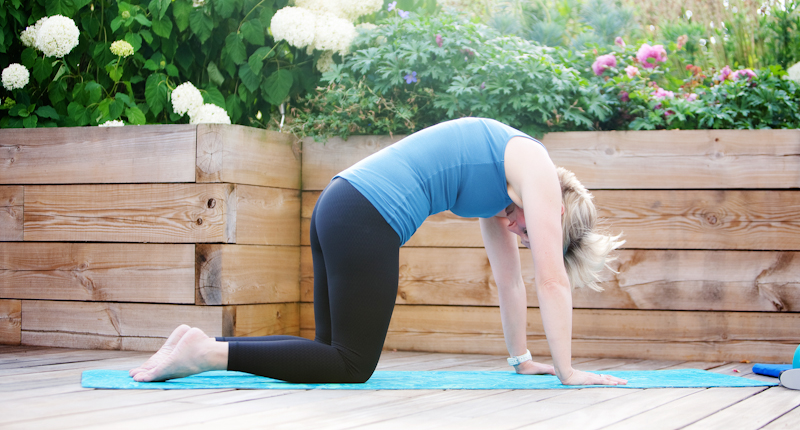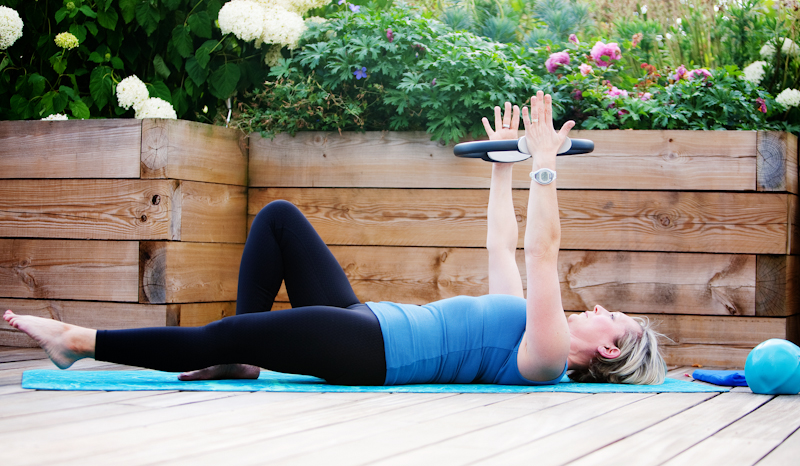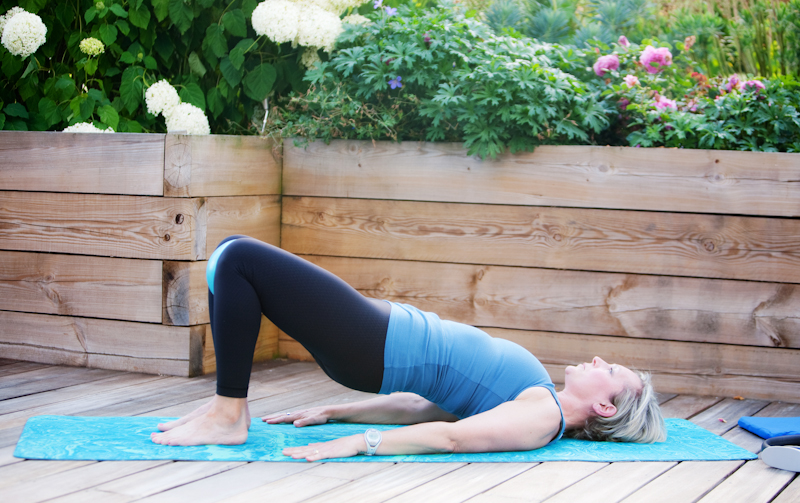If you were into fitness before your stoma surgery, you likely have lots of questions about how to exercise and the things you should do and those you should avoid.
We are often told not to lift anything heavy when we have surgery, but that does not mean forever; it’s really only for the first few weeks, and even then, I would like to see a more personalised and less restrictive approach – what’s heavy for one person may not be for another. The problem with this advice is that it also sows seeds of fear, often worrying those with a stoma that lifting something might cause damage or be the cause of a hernia. So try not to hang on to the ‘don’t lift’ advice for too long and work on your core control and strength to reduce hernia risk.
Muscle is important for your health
From a health perspective, it is hugely important to rebuild your strength and muscle mass after a period of illness and surgery. Using resistance training (with weights, resistance bands or body weight) is really the only way to do this effectively.
A period of only 10 days in hospital or on ‘bed rest’ can lead to at least a 10% loss of muscle mass and around 30% of muscle strength – equivalent to ageing about 10 years. No wonder we feel as if we’ve aged significantly when we shuffle out of hospital. If we don’t rebuild this using resistance training, we may never make a full recovery. Contrary to opinion/advice, it is likely that our risk of hernia will decrease if we engage in safe and appropriate lifting, resistance training and core work.
You have full permission to head back to the gym – you just need to do it in the right way.
What’s the ‘right way’?
Using weights, bands or body weight either in the gym or at home should be an essential ingredient in your recovery and life ‘post-stoma surgery’. Having good muscle strength is key for your health, reducing the risk of diabetes, osteoporosis and suffering from falls as you get older. The World Health Organization recommends all adults should do at least two strength training workouts each week for good health. And that applies to people with a stoma too.
Weight lifting
The first thing to know is that you can and should exercise when you have a stoma. You can eventually lift weights, do strength training and you can do core exercises such as planks. However, everyone is different and how you exercise is super important.
Your technique, the exercises you choose, the weight/reps you use are all important factors, and you must apply a gradual and individual approach to your recovery
and rebuild, over many months.
You might also need to modify some exercises and movements depending on the surgery you had, the illness leading to your surgery and your own fitness level. And this may mean doing things differently from how you did them before.
What you cannot do, is just have surgery, rest for 6 weeks then go back to doing exactly the same routines as before. There has to be a rebuilding period, focused core rehab and a gradual graded return – almost like you’re a beginner again.
One thing is for sure: everyone with a stoma needs to work on their core strength before stepping into a gym or picking up a weight. In my opinion (as an exercise physiologist of 30 years and owner of a stoma for 13 years) once you have a stoma, core training needs to be part of your life forever.
Core first
Core exercises are the foundation and should be the priority for everyone, whether you had surgery last week or 10 years ago.
At some point post-surgery – depending on your recovery – you need to start some core exercises. This could be as soon as a few days if you’re doing well, or you might feel ready a few weeks or months later. Either way, start with things like pelvic tilts, bridges, knee rolls, leg slides and lying arm circles, exercises on hands/knees box position (clinical pilates and physiotherapy type exercises) and finding a way to engage with your deep core muscles using the diaphragm breathing technique. These exercises start by ‘engaging’ with your deep core and pelvic floor muscles – you need to be able to engage your brain with a muscle before you can start to strengthen it.
 Cat stretch on hands and knees
Cat stretch on hands and knees

Leg slide

Bridge
Where to find these exercises?
I wrote the me+recovery programme at Convatec and this can be started as soon as 3–5 days after surgery – or any time when you are ready. In addition, you can access my online videos at www.theostomystudio.co.uk, featuring follow-along classes and videos. Most of the stoma bag companies will also have some sort of core exercise leaflet or booklet, which is a great place to start. Make sure to ask your stoma nurse, stoma bag supplier or delivery company.
Remember this is ‘rehabilitation’ and is part of your journey back to the gym. Your deep core needs to be engaged and connected for you to control your form, technique and intra-abdominal pressure.
Everyone needs to start with these exercises regardless of when their surgery was.
The next step is to begin progressing to more challenging movements and core-specific exercises. Gently feel your way into a new exercise and watch out for any feeling of bulging, doming of your abdomen or lack of control.
Progression might be things like a side plank, gentle half curl-ups (with feet on the floor), half planks, 90/90 knees (on your back) with toe taps and so on. You are not ready to dive into full planks, straight leg lifts, v-sits and high-intensity interval training (HIIT) just yet.
A gradual and progressive approach over a 3–6 month period is a reasonable aim.
Work with a fitness instructor who has more clinical or medical experience (usually in cancer), or a physiotherapist/rehab specialist, exercise professional/personal trainer/clinical pilates teacher.
After some time, you could work towards a typical ‘beginner pilates class’ around 3–4 months post-surgery, but this is not a starting point. Ultimately you may be able to build up to more advanced pilates by 6–8 months post-surgery – this might include full planks and teaser exercises etc. Your situation/surgery dictates
On the whole, you need to consider two main factors in terms of how quickly you can return to exercising and whether you need any modifications or adjustments:
1. Your fitness history and how fit you were just before your surgery or illness
If you were super fit/otherwise healthy and you had minimal complications/a short hospital stay (days rather than weeks), you may be able to have a less restrictive return to exercise. However, if you were very unwell before surgery and had an enforced break from exercise for weeks or months, then you will need a more progressive gentle return and may have to spend longer building back up.
2. The complexity/extent of your surgery, complications and other treatment (such as chemo)
There are many different types of stoma surgery. Having your rectum removed and had a surgery called abdominoperineal excision of rectum (APER) (or had any kind of pelvic floor reconstruction or surgery) is considered a ‘more complex’ surgery. A slower recovery can be expected, with potent modifications to exercise. The involvement of your pelvic floor may require you to slow down and modify your return to heavy lifting and high-impact activities (running and HIIT).
Equally, if you had complications (infections, time in the intensive therapy unit) lost a lot of weight/muscle and are having chemotherapy, your recovery might need a different focus or a slower, more graded approach.
However, if you had a stoma formation or keyhole surgery, with minimal complications, you can take a less restrictive approach.
Sarah’s top stoma exercise tips
- Pay attention to your form and technique. Small things can make a difference to your control of your intra-abdominal pressure. Good alignment of your torso, head and shoulders is key in all positions
- Always breathe ‘out’ or exhale on the ‘exertion’ part of a movement or lift (ie breathe out as you push the bar away in a bench press)
- Start with dumbbells or bands first before progressing to a bar
- Start with ‘single arm’ unilateral exercises before returning to bilateral exercises, such as dumbbell curls with alternating arms is less strain for the core than a classic dumbbell curl with both arms/using a bar
- Start with higher reps and lower weights (12–15 rep range) and gradually add weight/lower reps over time
- Breathe through a movement/lift rather than holding your breath or holding an ‘isometric’ position – in fact, never hold your breath in any exercise or lift ever again.
- Start with around 30-50% of what you were doing before – 30–50% of the weight, 30–50% of the reps and 30-50% of the of volume of time/distance etc.
- Use the three-rep assessment: try the first repetition of a movement/exercise and see how it feels, if there’s any soreness or discomfort, don’t stop, but gently try a second and third rep. If it’s getting better then continue, if it’s getting worse, then stop, change the exercise or return to it in a few weeks. This applies to core work mostly, but also watch out for soreness/tightness around your stoma/incisions when doing other exercises
- Give yourself plenty of recovery and expect more muscle soreness after a usual session. This won’t last forever and your recovery will improve.
The ‘rest for 6 weeks’ myth
First of all, the ‘6-week’ recovery timeframe isn’t based on any clinical evidence, and in my opinion, is one of the most unhelpful recommendations after someone has stoma surgery.
Rest is not rehabilitation. It doesn’t help us recover and we can’t just magically ‘go back to normal’ 6 weeks after surgery. If anything, we’ll be even more deconditioned and weak.
The immediate period after surgery (usually 6–12 weeks – but could be longer in very unwell people) should be considered as a rehabilitation phase (balanced with rest and sleep), including mobilisation, walking, light strength exercises (where appropriate) and core muscle exercises. All gradually progressing during the post-op period and returning you to your ‘pre-surgery’ baseline. This has several benefits including mental well-being, confidence, independence, rebuilding muscle strength and core rehabilitation.
Good luck and enjoy the feeling of getting stronger. Remember that you know your body best, but learn to find the ‘sweet spot’ of respecting the surgery you’ve had and respecting your stoma, but not being fearful to move, lift and exercise in an appropriate way. Trust yourself, you’ve got this.
Returning to exercise - graded list - first to last
There is no timeframe as everyone is different and this is not a definitive list, but it provides some framework and structure of how to progress and which things to start with and which things to come to last. This process might take many months – or even years in some cases – and the goal is NOT to achieve the full list. For some people the latter exercises may never be possible, desired or appropriate. Work with your own goals and your own previous and current fitness level. Remember that you need to do your core exercises first, before starting any formal exercise in this list, and to continue to do so as you progress and likely forever more.
FIRST
- Walking/jogging on treadmill
- Static Bike (if comfortable on rectum)
Isolated exercises with dumbbells or a band, such as bicep curls, single arm dumbbell rows, upright rows, bench press, shoulder press(often seated, but standing is ok too) - Body weight lunges, squats and calf raises: add weights with kettlebells and dumbbell first before a bar
- Beginner level 1 pilates exercises: with head and feet on floor (at least one foot)
- Push-ups on knees or against the wall
- Seated weights machines, such as row, chest press, shoulder press, leg extension and leg curls (with light weights)
- Pulling movements, such as TRX rows, barbell rows etc
- Intermediate Pilates exercises: either head or feet are lifted (or both), modified half plank, side planks etc
- Leg press (lightweight to start with, heavyweight will always increase abdominal pressure)
- Pull ups (use assistance with a platform or bands first)
- Heavy pushing movements inc bench press and full push ups
- Rowing ergometer (lengthy spells or hard rowing will increase abdominal pressure). Some may wish to avoid the rower altogether
- Burpees, full pull ups with no assistance
- HIIT/circuit type training
- Full plank on elbows
- Advanced Pilates exercises – full roll ups and roll downs,
- Sit-ups/Russian twists/v sits
- CrossFit/tyre flipping etc
- Heavy deadlifts, back squats, Olympic bar lifts: start with a light weight/high reps and increase reps/sets before adding weight
LAST
Disclaimer This article does not provide medical advice. It is intended for general information only. Following any recommendation in this article is at your own risk, and it is recommended that an individual should work with a qualified exercise professional and consult their nurse or doctor before starting an exercise programme.
 Sarah Russell is a clinical exercise physiologist, pilates instructor and author of ‘The Bowel Cancer Recovery Toolkit’
Sarah Russell is a clinical exercise physiologist, pilates instructor and author of ‘The Bowel Cancer Recovery Toolkit’
www.theostomystudio.co.uk

